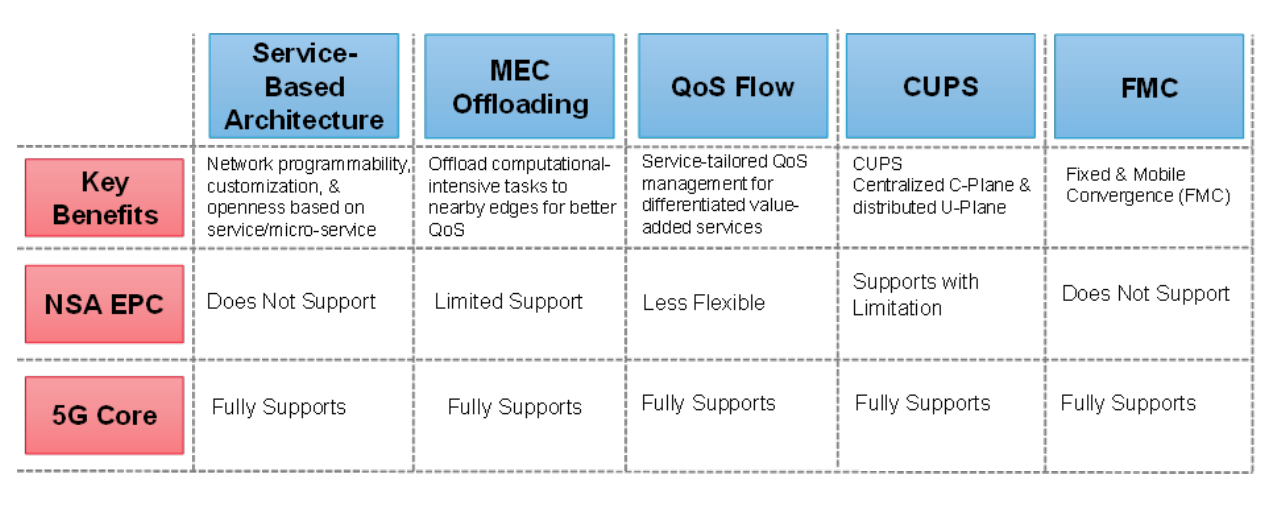5G Core (5GC) networks provide a superior cellular experience for end users and service flexibility for Mobile Network Operators (MNOs). At the heart of every cellular network is the underlying architecture. That’s why it’s so important for operators to analyze the pillars of 5G core network architecture.
This article will answer the following questions:
- What makes 5G core architecture different from Evolved Packet Core (EPC)?
- How will the new architecture impact 5G Core Network Functions (CNFs) and network elements?
- In what ways does 5G core architecture benefit Communication Service Providers (CSPs)?
- Where does the value of Control and User Plane Separation (CUPS) exist in these core networks?
What Makes 5G Core Architecture Different?
As reported in our 2023 technology trends paper, EPC may not be well-suited for new growth in 5G Non-Standolne (NSA) networks. 5G NSA offers a solid starting point for enhanced bandwidth and network capacity needs at a lowe cost per Megabyte (MB).
The architectural evolution of 5G core creates a considerable gap between it and EPC architecture. The technological underpinnings of 5G core architecture consist of a cloud-native, granulated configuration of loosely coupled and autonomous network components. Moreover, 5G core uses Service-Based Architecture (SBA), which is software-based and hosted in the cloud.
With point-to-point EPC architecture, you’re dealing with element interfaces delineated by box-specific “reference points.” Moreover, EPC involves a responsibility overlap between the various network elements. The architectural advancements of the 5G core come from the way NFs operate. More specifically, 5G network elements are no longer “boxes”; instead, the elements are “software NFs.” Additionally, core network elements go from being “protocols” to “Application Programming Interfaces (APIs).”
Figure 1: EPC versus 5G Core Architecture

5G Service Atomicity
Service “atomicity,” which refers to microservices running in isolation from concurrent processes, is one of the greatest benefits of 5G core architecture for CSPs. This 5G core feature translates into the ability for NFs to scale and upgrade independently of each other.
As a result of the disaggregated nature of 5G core architecture, CSPs gain greater network flexibility. For example, mobile operators can introduce upgrades and new functionalities without affecting any running services.
Benefits of CUPS in 5G Core Architecture
5G core fully supports Control and User Plane Separation (CUPS), which is a transformative change in 5G NSA architecture compared to EPC NSA networks. Whereas CUPS is supported in a limited capacity for 4G/Long-Term Evolution (LTE) networks, the full potential of this architecture is realized in 5G networks. Plus, CUPS is a necessity for 5G core in order to support use cases such as network slicing.
As seen with many CSPs in China, CUPS enhances resource distribution within the cellular network. The greatest value of CUPS for 5G core lies in its ability to bring cellular service closer to users. To elaborate, the functional separation with CUPS enables Control-Plane (C-Plane) workloads to be hosted centrally, while User-Plane (U-Plane) workloads can be scaled separately from the C-Plane.
Crucially, this architecture removes the requirement for network traffic to be backhauled to a central location. Accordingly, mobile service providers and end users can expect improved latency and bandwidth—each of which is key to applications like video, connected cars, gaming, etc.
Because the architecture of 5G core networks is software-defined and decentralized, CSPs can accelerate the time to develop applications and services. More than that, a convergence of CUPS and SBA allows MNOs to employ Information Technology (IT)-centric nimbleness.
This architectural approach is favorable to EPC software, which is not lightweight, necessitates manual mediation, and often requires dedicated maintenance windows for latency-sensitive and high-throughput operations.
Sign Up with ABI Research
Do you work for a mobile service provider or a cellular equipment vendor and want to keep up to date on the latest technological trends in the cellular technologies space? Subscribe to ABI Research’s 5G Core & Edge Networks Research Service today.
Related Content:
5 Ways for CSPs to Succeed on the 5G Core (5GC) Network Front [Research Highlight]
How CSPs Should Set the Stage for NaaS [Research Highlight]
The Five Myths of 5G [Whitepaper]
The Promising Outlook for 5G [Infographic]




